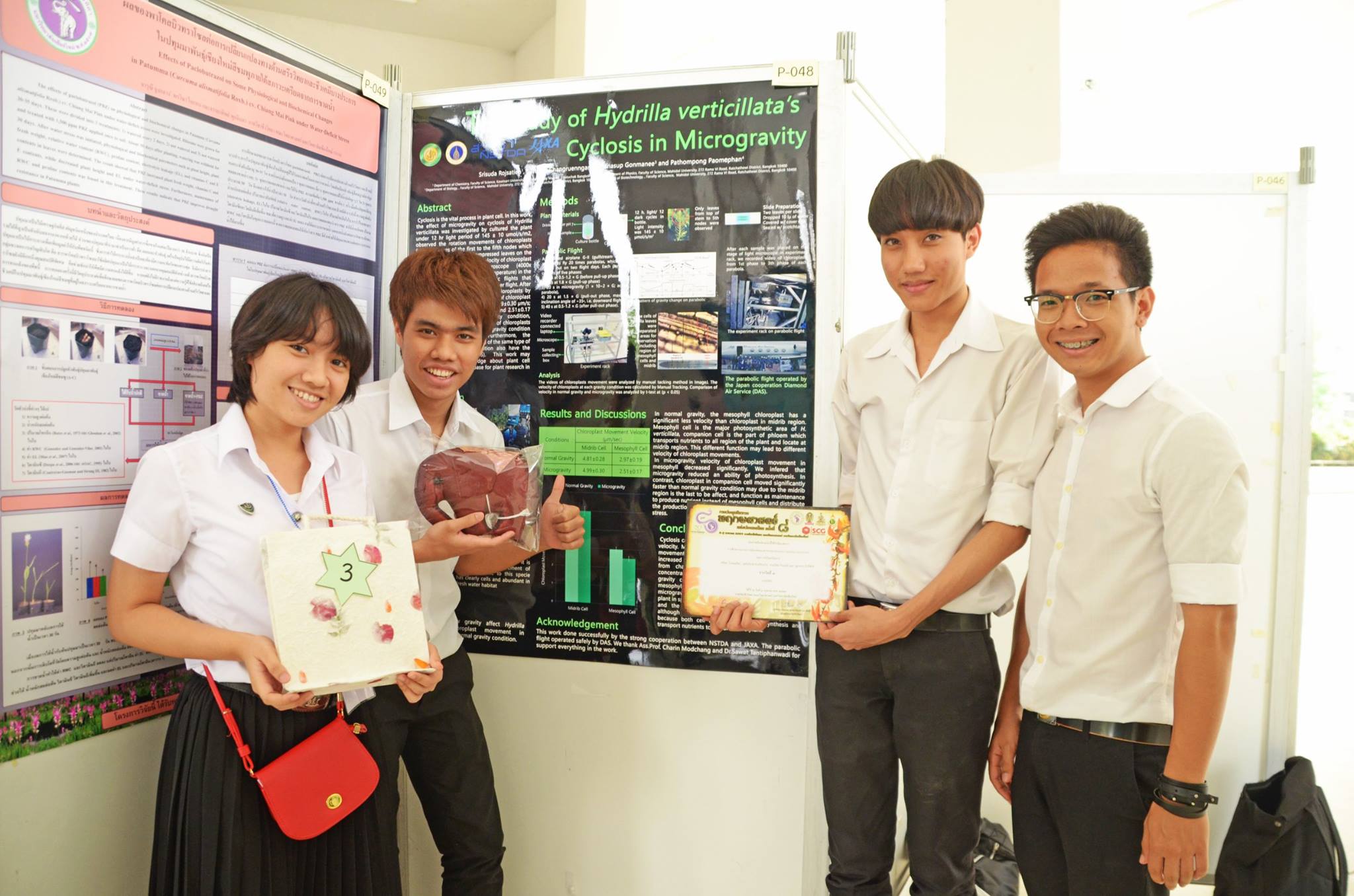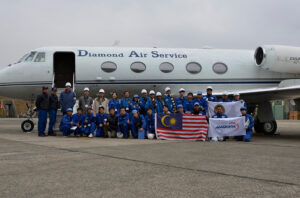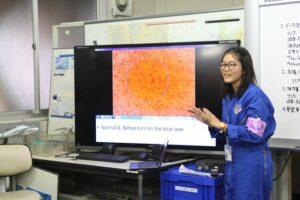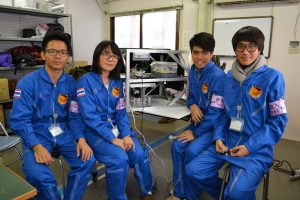
การศึกษากระบวนการไซโคลซิสของสาหร่ายหางกระรอก (Hydrillaverticillata) ในสภาวะไร้แรงโน้มถ่วง
The Study of Hydrillaverticillata’s Cyclosis in Microgravity.
ศรีสุดา โรจน์เสถียร สุทธิเกียรติ ช่างเรือนงาม ธนทรัพย์ ก้อนมณี2 และ ปฐมพงษ์ เป้ามีพันธ์2
Srisuda Rojsatien1, Suttikiat Changruenngam2, Thanasup Gonmanee2 and Pathompong Paomophan2
บทคัดย่อ
กระบวนการไซโคลซิส (cyclosis) เป็นกระบวนหนึ่งที่สำคัญของเซลล์พืชในงานวิจัยนี้ได้ศึกษาผลของสภาวะไร้แรงโน้มถ่วง (microgravity) ที่มีต่อกระบวนการไซโคลซิสของสาหร่ายหางกระรอก (Hydrillaverticillata) โดยเลี้ยงสาหร่ายหางกระรอกภายใต้แสง145 ± 10 µmol/s/m2 เป็นเวลา 12 ชั่วโมงต่อวัน,เลือกใช้ใบสาหร่ายหางกระรอกที่อยู่ด้านล่างส่วนยอดที่มีใบเบียดกันอย่างหนาแน่นลงมา 1-5 ข้อ,ใช้ตัวอย่างจำนวน 16 ใบ และนำไปศึกษาการเคลื่อนที่ของคลอโรพลาสต์แบบหมุนวนรอบเซลล์ (rotation movement) ภายใต้กล้องจุลทรรศน์แบบใช้แสงที่กำลังขยาย 4,000 เท่า ในเครื่องบินที่สร้างสภาวะไร้แรงโน้มถ่วง 20วินาทีต่อรอบการบินซึ่งมีจำนวนรอบการบิน20 รอบบินที่อุณหภูมิภายในเครื่องบินเท่ากับ 27±2 องศาเซลเซียสจากการวิเคราะห์อัตราเร็วเฉลี่ยของคลอโรพลาสต์โดยโปรแกรมอิมเมจเจ(ImageJ)พบว่าคลอโรพลาสต์ในเซลล์เส้นกลางใบเคลื่อนที่ด้วยอัตราเร็วเฉลี่ย4.81±0.28 µm/s และ4.99±0.30µm/s;ในเซลล์มีโซฟิลล์เคลื่อนที่ด้วยอัตราเร็วเฉลี่ย2.97±0.19 µm/s และ2.51±0.17 µm/sสำหรับสภาวะแรงโน้มถ่วงปกติและไร้แรงโน้มถ่วงตามลำดับ ซึ่งอัตราเร็วเฉลี่ยของคลอโรพลาสต์ในเซลล์ชนิดเดียวกันแต่อยู่ในสภาวะแรงโน้มถ่วงต่างกันจะมีค่าแตกต่างกันอย่างมีนัยสำคัญ นอกจากนี้อัตราเร็วเฉลี่ยของคลอโรพลาสต์ในเซลล์ต่างชนิดที่อยู่ในสภาวะแรงโน้มถ่วงเดียวกันก็มีความต่างกันอย่างมีนัยสำคัญทางสถิติเช่นกัน (p<0.05) ทั้งนี้ผู้วิจัยหวังว่างานนี้จะเป็นข้อมูลพื้นฐานในการศึกษาสรีรวิทยาของเซลล์พืช และเป็นข้อมูลสำหรับการวิจัยพืชในอวกาศต่อไป
คำสำคัญ: กระบวนการไซโคลซีส, สาหร่ายหางกระรอก, สภาวะไร้แรงโน้มถ่วง
Abstract
Cyclosis is the vital process in plant cell. In this work, the effect of microgravity on cyclosis of Hydrillaverticillata was investigated.The plant was culturedunder12 hr light period of 145 ± 10 umol/s/m2. Therotation movement of chloroplasts was observed in 16 leaves from the first to the fifth nodes which were next to the cluster of compressed leaves on the top of stem.The velocity of chloroplast movement was measured under light microscope (4,000x magnification) at 27±2 ˚C (plane temperature) in the plane which provides 20 parabolic flights that operates microgravity for 20 seconds per flight. The average velocity of chloroplasts was analyzed using the Image J program.It was found that the average velocity of chloroplast in the midrib cell was 4.81±0.28 µm/s and 4.99±0.30 µm/s; in mesophyll cell is 2.97±0.19 µm/s and 2.51±0.17 µm/sin normal and microgravity condition, respectively. The average velocity of chloroplasts from the same types of cell under the different gravity conditions was significantly different. Furthermore, the average velocities of chloroplasts of the different types of cell under the same gravity condition was also significantly different (p<0.05). This work will provide the basic knowledge about plant cell physiology and information for future plant research in the space.
Keywords :cyclosis, Hydrillaverticillata, microgravity
_____________________________________
1ภาควิชาเคมี คณะวิทยาศาสตร์ มหาวิทยาลัยเกษตรศาสตร์ 50 ถนนงามวงศ์วานแขวงลาดยาว เขตจตุจักร กรุงเทพฯ 10900
Department of Chemistry, Faculty of Science, Kasetsart University 50 Ngam Wong Wan Rd, Chatuchak Bangkok 10900
ภาควิชาฟิสิกส์, ภาควิชาชีววิทยา และ ภาควิชาเทคโนโลยีชีวภาพคณะวิทยาศาสตร์ มหาวิทยาลัยมหิดล 272 ถนนพระรามที่ 6 แขวงทุ่งพญาไท เขตราชเทวี กรุงเทพฯ 10400
Department of Physics, Biology and Biotechnology, Faculty of Science, Mahidol University, 272 Rama VI Road, Ratchathewi District, Bangkok 10400







